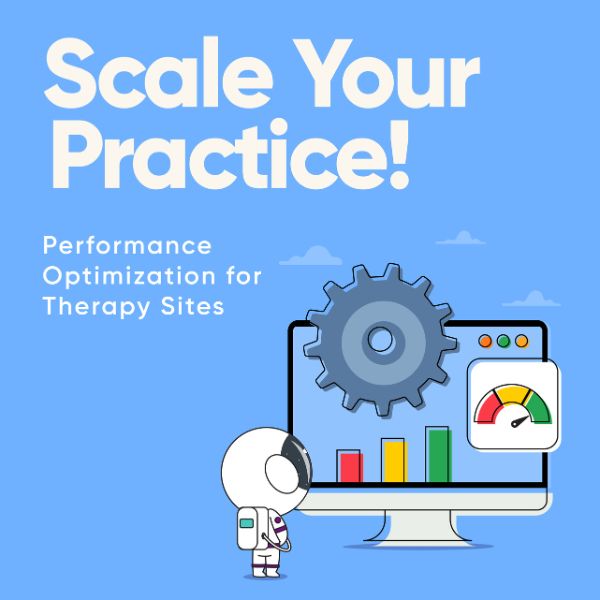Website Performance Optimization for Therapy Websites

Table of Contents
Why Performance Optimization for Therapy Websites is Important

When people search for therapy, they often go online to find help. If a therapy website is slow or not working well, it can turn people away, and they might find help somewhere else. To prevent this, it’s essential to make sure your therapy website works smoothly and quickly. This way, people looking for therapy can stay on your site and get the support they need without any issues.
The Basics of Performance Optimization
Now that we know how important it is to make your therapy website work better, let’s check out some basic ways to make it faster and work smoother.
Optimize Images and Multimedia Content
To make therapy websites work better, you need to make pictures and videos smaller. Big files slow down websites, so it’s important to shrink images without making them look bad. This helps pages load faster, and it also makes your website easier to use on phones.
When fixing up therapy websites, you have to find the right balance between making things look nice and making them load quickly. By using smaller images and organizing videos properly, you can create a website that looks good and works smoothly on different devices, making it enjoyable for people to use.
Prioritize Content Delivery
Make your therapy website work faster by putting content delivery first. Think of it like having helpers worldwide – Content Delivery Networks (CDNs) – spreading your website stuff so it doesn’t have to travel far when someone checks your site. This makes pages load quicker.
If your website is the main spot, CDNs are like helpers in different places globally. They keep copies of your stuff, so when someone wants to see your website, they get it from the closest helper. This helps your website do better, especially for people far from your main spot.
For therapy websites, this is super important. It means people worldwide can see your stuff fast. By using CDNs, you’re making sure anyone looking for support can easily connect to your website without waiting.
It’s a simple but strong way to make your therapy website faster and reach more people. Successful therapy websites swear by this – it’s like having a worldwide team of helpers for your website!
Streamline Website Design
Simplify your website’s design to make it work better. If your site is too busy, it might be slow. To fix this, make the design simpler by removing unnecessary stuff and focusing on what’s important. Choose a clean and easy-to-use layout that helps visitors find what they need easily.
For therapy websites, keeping things simple is important for better results. A straightforward design not only makes it easier for people to use your site but also ensures it loads fast. This matters because a fast website catches the eye of potential clients, making them more likely to check out your services.
Successful therapy websites recommend streamlining design for a smoother experience. They also stress the importance of testing your site on different devices to make sure it works well everywhere. By simplifying your website and testing it on various devices, you can make your psychiatry site more effective, helping you connect better with your audience. Testing the site’s performance is key to confirming that the design is functional and fast on all platforms. Using automation testing tools can help you run these tests efficiently, allowing you to catch issues early and make improvements quickly. This ensures your therapy website is not only user-friendly but also reliable, offering potential clients a seamless experience.
Advanced Tips for Optimal Performance

Now that we’ve talked about the basic ways to make your therapy website work better, let’s check out some more advanced tips to make it even better.
Minimize HTTP Requests
Cutting down on how many times your therapy website asks for things is super important. Think of each picture, script, or style thing as a request. The more requests your site makes, the slower it loads.
To speed things up, you can mix CSS and JavaScript files, use fewer outside scripts, and make your code better. Doing these tweaks makes your therapy site much faster.
Why should you care? Well, when your website is faster, people using it have a better time. Nobody likes waiting forever for a site to load, right? Successful therapy websites agree – they make sure their sites load quickly and smoothly.
Try looking at your website on a computer, tablet, and phone. This helps you know if your site works for everyone. Testing on different devices is like a checkup to make sure your website looks good and works well everywhere. When you make these changes, your site gets faster, and everyone who comes to visit has a good experience.
Implement Browser Caching
Adding browser caching to your therapy website is a smart move. Let me explain it in simple terms. When someone visits your site for the first time, certain parts of it get saved on their device.
Now, when they return, their browser can quickly show the page by using these saved files instead of downloading everything again. This makes your site load faster.
By setting expiry dates for different types of content, you balance having the latest information and making your site load quickly. Why is this important for your therapy website? Well, it ensures that when people come back, they can find what they need fast, without any annoying delays.
Successful therapy websites have a good word about this because it enhances the user experience. Think of it like having a shortcut to important details. Also, it’s a good idea to monitor how your site looks and works on different devices. This helps you make sure that whether someone is using a computer, tablet, or phone, your website gives them a smooth experience.
Optimize Server Response Time
Making your therapy website faster is important. When someone visits your site, how quickly it responds matters a lot. To speed things up, you can upgrade your hosting plan, use fewer complicated scripts, and fix any problems slowing down your server.
Why does this matter for your website? Well, a faster website means people can explore your therapy services without waiting too long. It’s like making a path for them to walk smoothly through what you offer.
Successful therapy websites also talk about this. They say that by making their server respond faster, people from different places can use their website easily. If you’re running a therapy website, focus on optimizing your server response time. It’s like opening the door for people to quickly and smoothly discover what you have to offer.
Content Strategies for Enhanced Performance

Beyond technical optimizations, the content on your therapy website plays a crucial role in engaging visitors and encouraging them to explore further. Let’s get into content strategies that complement performance optimization, creating a well-rounded online presence.
Crafting Compelling Headlines and Meta Descriptions
The first interaction visitors have with your website is often through search engine results. This not only enhances your website’s click-through rate but also sets the tone for a positive user experience.
Performance optimization for therapy websites extends to the realm of content creation, ensuring that every element, from headlines to meta descriptions, is crafted with both search engines and human readers in mind.
Creating Engaging and Informative Content
A therapy website should be a valuable resource for individuals seeking support and information. Regularly update your website with engaging and informative content that addresses common concerns, offers insights, and provides a glimpse into your therapeutic approach. This not only keeps your audience informed but also positions you as an authority in the field.
Performance optimization for therapy websites goes hand-in-hand with content creation. Quality content not only attracts visitors but also encourages them to spend more time on your site, positively impacting overall user engagement.
Incorporating Visual Elements
Visual elements, such as images, infographics, and videos, can enhance the overall appeal of your therapy website. Use high-quality, relevant visuals to complement your written content. Ensure that images are appropriately sized and optimized for quick loading, contributing to a seamless and visually pleasing user experience.
Performance optimization for therapy websites involves striking a balance between visual appeal and load times. By incorporating optimized visual elements, you create a website that is not only informative but also aesthetically pleasing.
Online Reputation Management

In the digital age, your online reputation is an extension of your practice. Performance optimization for therapy websites should also consider strategies for managing and enhancing your online reputation.
Client Testimonials
Show off what your clients have to say about your therapy services! Put their positive feedback front and center on your website. Good reviews help build trust and prove that you’re really good at what you do. Ask happy clients to share their experiences, and you’ll have a collection of real stories that can connect with potential clients.
When it comes to optimizing your therapy website’s performance, featuring client testimonials is a key move. It’s not just about looking good online; it’s about making visitors feel sure about choosing your therapeutic services. Consider what successful therapy websites say – they often highlight positive client experiences to create a welcoming online space. So, why not let client testimonials speak for themselves and boost your therapy website’s appeal?
Online Presence Across Platforms
Keep your online presence in check across different places. From your social media pages to online listings, make sure your therapy details are right and current. This doesn’t just help with how search engines find you but also makes it easy for people looking for info about your therapy to get the right stuff.
When you work on making your therapy website perform well, it’s linked with having a consistent online presence. This not only builds a good image and makes you visible but also helps potential clients easily get the right information about your therapy when they search. And you know how important it is to be found and trusted, especially in the world of therapy websites.
Engagement on Social Media
Connect with your audience on social media for better engagement. Share helpful info, answer questions, and join discussions about mental health. Being active on social media not only broadens your reach but also boosts your practice’s trustworthiness and relatability.
Optimizing performance for therapy websites goes beyond just the website; it includes your social media game too. This creates a harmonious online presence that builds trust and strengthens connections. Successful psychiatry websites vouch for the positive impact of an interactive social media approach.
By actively participating in various social media scopes, you not only expand your online presence but also establish credibility and a more meaningful connection with your audience.
Transforming Your Online Presence Through Performance Optimization

Making your therapy website work its best isn’t just about tech stuff. It’s about creating a friendly space for those who need support. Easy tricks, like fixing pictures and making the design smoother, can make your therapy services reach more people.
Remember, it’s not just about having any website. It’s about having one that works well, connects with your audience, and makes meaningful connections. As you make your website better, keep these tricks in mind and see your online presence grow.
Making your therapy website perform well is an ongoing job. Check how it’s doing regularly with tools like Google PageSpeed Insights. Make changes as needed and keep up with new tech and good practices. This keeps your therapy website up to date and easy for users.
The journey of fixing up your therapy website is always changing. Use simple and advanced tricks to create an online space that shows your style and connects with those who need support. It’s not just about having a website, but having one that keeps getting better for everyone who visits.
Now, when it’s time to do the practical stuff, plan with me to figure out who your best clients are and how your website can grab their attention. I’ll create a website that reflects you and brings in the right clients. When it’s live, you’ll have a website you can be proud of.
I won’t stop supporting you even after your site is live, making sure things run smoothly and helping your private practice do well.
I’m here to help counselors and therapists make a bigger impact with websites that look good and work smart. Let’s team up to create sites that really connect with your clients. If you’re interested, schedule a discovery call to learn more about how we can make your online presence even better.
Hi! I’m Sarah.
I help counselors and therapists have a bigger impact on the world through better client connection. I do this by creating beautiful visuals and strategically designed websites.

Related Reads for SEO:
- Website Performance Optimization for Therapy Websites
- Find the Right Keywords For Blog Post | Local SEO Strategies
- Unlocking the Power of SEO Keywords for Therapists
- Do I Need An SSL Certificate For My Website – Security for Your Therapist Website
- SEO For Therapists: The Ultimate Guide
- Responsive Website Design Service For Therapists
- 3 Best Tips in SEO for Therapist Websites
- How Adding A Blog To Your Website Helps Your Therapy Business
- Secure Website Design for Mental Health Professionals
- Top 10 SEO Web Work Services for Boosting Your Website’s Visibility
- Why Help with Website Design Can Improve Your Practice
- Why Doesn’t My Website Show Up on Google Search? Common Issues and Fixes
- Top 10 SEO Web Work Services for Boosting Your Website’s Visibility
Need any of the following?
Here are some Sample Websites We’ve Created:
Check out our Portfolio for more!

